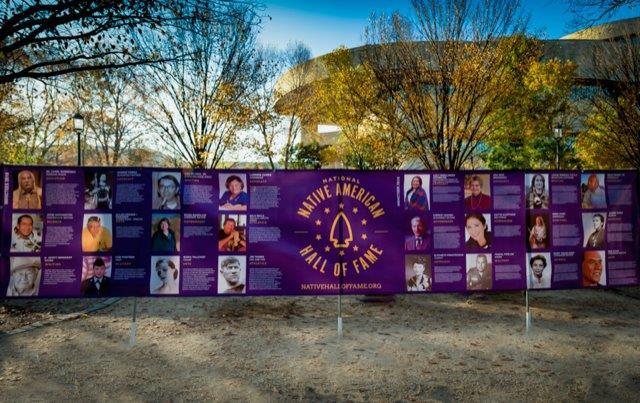National Native American Hall of Fame announces 8 new nominees
Earlier in May, the National Native American Hall of Fame (NNAHOF) this week announced eight new inductees from across Indian Country, celebrated for their contributions in Native advocacy, politics, athletics, arts, health, and culture preservation and revitalization.
Inductees include: Dave Anderson (Ojibwe), a businessman and entrepreneur; Sen. Ben Nighthorse Campbell (Northern Cheyenne); Joy Harjo (Muscogee Creek), a poet; Marcella LeBeau (Cheyenne River Sioux), a health policy leader; Emil Notti (Athabascan), a political leader; Katherine Siva Saubel (Cahuilla), a language preservationist and museum founder; Ernie Stevens Sr. (Oneida), a Indian Policy leader; and W. Richard West, (Southern Cheyenne/Arapaho), the founding director of the National Museum of the American Indian.
2021 marks the third cycle of awards bringing the total number of Hall of Fame members to 32 living and past Native American and Alaska Natives that have made significant contributions to Indian Country. Inductees are selected by the Hall of Fame Board Directors, based on public input, research, and a matrix to ensure fair representation among tribal nations, according to the group’s founder and CEO, James Parker Shield, Little Shell Chippewa. The Hall has a large pool of potential inductee and Shield encourages people to nominate others… A complete list of previous honorees can be found on the website www.NationalNativeNativeHallofFame.org.
“One thing we try to do is make sure this doesn’t boil down to a popularity contest where only the well-known Native Americans are selected,” Parker Shield. “We want to make sure that even those people that are not well known—that maybe toiled in obscurity—but nonetheless worked to improve things for their people or Native Americans as a whole are recognized.”
The 2021 honorees will be officially inducted into the Native American Hall of Fame on Nov. 6 at the site of the future museum in Oklahoma City, Okla. The organization has signed a memorandum of agreement with the First Americans Museum there to build a new wing onto the existing building, Parker Shield said. Pending an ongoing capital campaign and seeking a funding appropriation from Congress, the wing could open in three years, he said. At present, the Hall of Fame exists largely on the internet, supported by an office in Great Falls, MT. “Being included in The First Americans facility expansion will be world class, allowing us to feature the honorees in an appropriate manner, a compliment to other exhibits at that institution. We are very hopeful and excited about the opportunity,”
“In my mind, the Hall of Fame for Native Americans, particularly recognizes Native Americans of contemporary history (1860-present),” he said. “Most Americas learn about Native Americans in books or in movies relating back to the old days. A lot of them can probably name people like Geronimo, Sitting Bull or Sacajawea etc., but they would be hard pressed to name any contemporary Native Americans or their accomplishments… That is important for the rest of America, but it’s even more important for our young Native Americans, because these people are inspirational.”
As part of its’ mission to educate and inspire, the Hall of Fame has developed a curriculum grades 8-12 based around the contributions and accomplishments of its honorees Developed by Shane Doyle, Crow Tribe who has a doctorate in education. Doyle. works with Montana State University developing curriculum to implement Montana’s Indian Education for All public law as well as the National Indian Education. The Hall of Famer curriculum project follows the advice of Elise Evans Roberts, Tlingit, of Niwot High school, Colorado: “Role models ae some of the most powerful people in the world, no matter their position in politics or leadership, because they can influence the mind of the next generation. Accomplishment by prominent Native American are not often taught, leaving Native students to their own device to learn about important and inspiring people like them.”
In conjunction with the educational curriculum the Hall of Fame developed a poster series featuring its honorees. Copies of these colorful and attractive posters were recently mailed to schools in Montana, Wyoming, North and South Dakota, Washington and Idaho. Both the curriculum and posters are available at no charge and Shield hopes that schools with large native populations, including BIA boarding schools will utilize the material. Contact James Parker Shield at james@nativehalloffame.org for more details.
Finally, the Hall of Fame has developed an educational/informational display with “pop-up” used at conferences and other meetings to promote the project. Another promotional effort to educate and celebrate the honorees is a 20’ colorful banner, (see photo accompanying this article) featuring many of the Hall of Famers. Last fall this banner was erected and displayed on the National Mall in front of the Museum of the American Indian, Washington, DC during Native American week.
“It’s been an exciting journey so far,” Shield commented. “From an idea to reality in four short years, made possible because of the overwhelming support of Native leaders and non-Indians who share the vision across the country. I hope the National Native Hall of Fame will become a permanent legacy to educate our own people and America about the amazing contributions of our contemporary Native American people.”
(Clara Caufield can be reached at acheyennevoice@gmail.com)
The post National Native American Hall of Fame announces 8 new nominees first appeared on Native Sun News Today.

